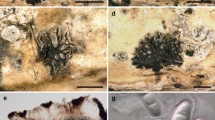Abstract
From the rich genus of Ciliata Peritrichida, comprising about 100 species, 8 taxa were selected, described, figured and classified saprobiologically (Table 1): Opercularia coarctata, O. confusa, O. minima, O. microdiscum, O. nutans, O. allensii, O. curvicaula and O. phryganeae. These species are considered as common and serving as best indicators of the saprobic conditions of their environment.
Similar content being viewed by others
References
Bick, H., 1972. Ciliated Protozoa. An illustrated guide to the species used as biological indicators in freshwater biology. — World Health Organization, Geneva, p. 198.
Corliss, J. O., 1979. The Ciliated Protozoa. Characterization, Classification and Guide to the Literature. Second Edition. — Pergamon Press, Oxford, p. 455.
Curds, C. R., 1964. The taxonomy of Pyxidiella curvicaula. — J. Protozool. 11: 552–554.
Curds, C. R., 1969. An illustrated key to the British freshwater ciliated protozoa commonly found in activated sludge. — Water Pollut. Res. Techn. Paper 12, pp. IV + 90, London.
Curds, C. R. & A. Cockburn, 1970. Protozoa in biological sewage treatment process. I. A survey of protozoan fauna of British percolating filters and activated sludge plants. — Water Res. 4: 225–236 — II. Protozoa as indicators in the activated sludge process. — Ibidem 4: 237–249.
Kahl, A., 1930–35. Urtiere oder Protozoa. I. Wimpertiere oder Ciliata (Infusoria). — Die'rierwelt Deutschlands Teil 18, 21, 25, 30, G. Fischer Vlg., Jena, p. 885.
Kralik, U., 1957–58. Untersuchungen über den Bewuchs von peritrichen Ciliaten in einigen Fliessgewässern bei Leipzig. — Wiss Z. Univ. Leipzig, math.-nat.-wiss. R: 7: 309–328.
Liebmann, H., 1962. Handbuch der Frischwasser- und Abwasser-Biologie. Bd. I., 2. Aufl. — G. Fischer Vlg., Jena, p. 588.
Nusch, E. A., 1970. Ökologische und systematische Untersuchungen der Peritricha (Protozoa, Ciliata) im Aufwuchs von Talsperren und Flusstauen mit verschiedenem Saprobitätsgrad (mit Modellversuchen). — Arch. Hydrobiol. Suppl. 37, 243–286.
Pantle, R. & H. Buck, 1955. Die biologische Überwachung der Gewasser und die Darstellung der Ergebnisse. — Gas and Wasserfach 96 (18): 604.
Sládecek, V., 1964. Zur Ermittlung des Indikations-Gewichtes in der Gewässeruntersuchung. — Arch. Hydrobiol. 60: 241–243.
Sládecek, V., 1973. System of water quality from the biological point of view. — Arch. Hydrobiol./Ergebn. Limnol. 7: 1–218.
Sládecková, A. & V. Sládecek, 1963. Periphyton as indicator of the reservoir water quality I. True-periphyton. — Sci. Pap. Inst. Chem. Technol., Prague, Technology of water 7(1): 507–561
Zelinka, M. & P. Marvan, 1961. Zur Präzisierung der biologischen Klassifikation der Reinheit fliessender Gewasser. — Arch. Hydrobiol. 57: 389–407.
Author information
Authors and Affiliations
Rights and permissions
About this article
Cite this article
Sládecek, V. Indicator value of the genus Opercularia (Ciliata). Hydrobiologia 79, 229–232 (1981). https://doi.org/10.1007/BF00006317
Received:
Issue Date:
DOI: https://doi.org/10.1007/BF00006317




